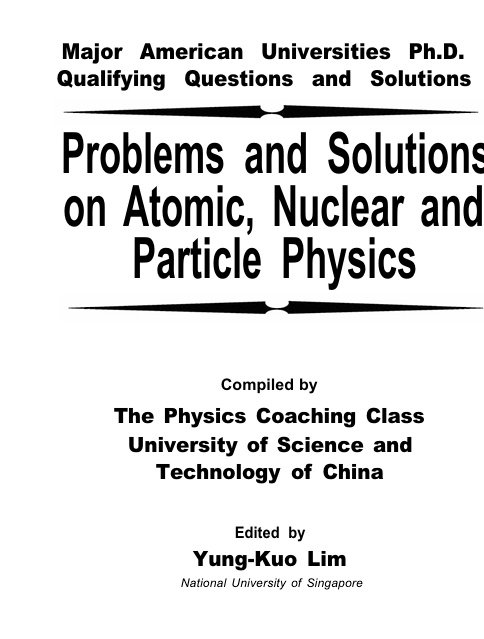
Problems and Solutions on Atomic, Nuclear and Particle Physics
Author: Yung-Kuo Lim Category: Educational Publisher: World Scientific Publishing ISBN: 981-02-3917-3This series of physics problems and solutions, which consists of seven
volumes — Mechanics, Electromagnetism, Optics, Atomic, Nuclear and
Particle Physics, Thermodynamics and Statistical Physics, Quantum Me
chanics, Solid State Physics and Relativity, contains a selection of 2550
problems from the graduate-school entrance and qualifying examination
papers of seven U.S. universities — California University Berkeley Cam
pus, Columbia University, Chicago University, Massachusetts Institute of
Technology, New York State University Buffalo Campus, Princeton Uni
versity, Wisconsin University — as well as the CUSPEA and C.C. Ting’s
papers for selection of Chinese students for further studies in U.S.A., and
their solutions which represent the effort of more than 70 Chinese physicists,
plus some 20 more who checked the solutions.
The series is remarkable for its comprehensive coverage. In each area
the problems span a wide spectrum of topics, while many problems overlap
several areas. The problems themselves are remarkable for their versatil
ity in applying the physical laws and principles, their uptodate realistic
situations, and their scanty demand on mathematical skills. Many of the
problems involve order-of-magnitude calculations which one often requires
in an experimental situation for estimating a quantity from a simple model.
In short, the exercises blend together the objectives of enhancement of one’s
understanding of physical principles and ability of practical application.
The solutions as presented generally just provide a guidance to solving
the problems, rather than step-by-step manipulation, and leave much to
the students to work out for themselves, of whom much is demanded of the
basic knowledge in physics. Thus the series would provide an invaluable
complement to the textbooks.
The present volume consists of 483 problems. It covers practically the
whole of the usual undergraduate syllabus in atomic, nuclear and particle
physics, but in substance and sophistication goes much beyond. Some
problems on experimental methodology have also been included.
In editing, no attempt has been made to unify the physical terms, units
and symbols. Rather, they are left to the setters’ and solvers’ own prefer
ence so as to reflect the realistic situation of the usage today. Great pains
has been taken to trace the logical steps from the first principles to the
f
inal solution, frequently even to the extent of rewriting the entire solution.
Back